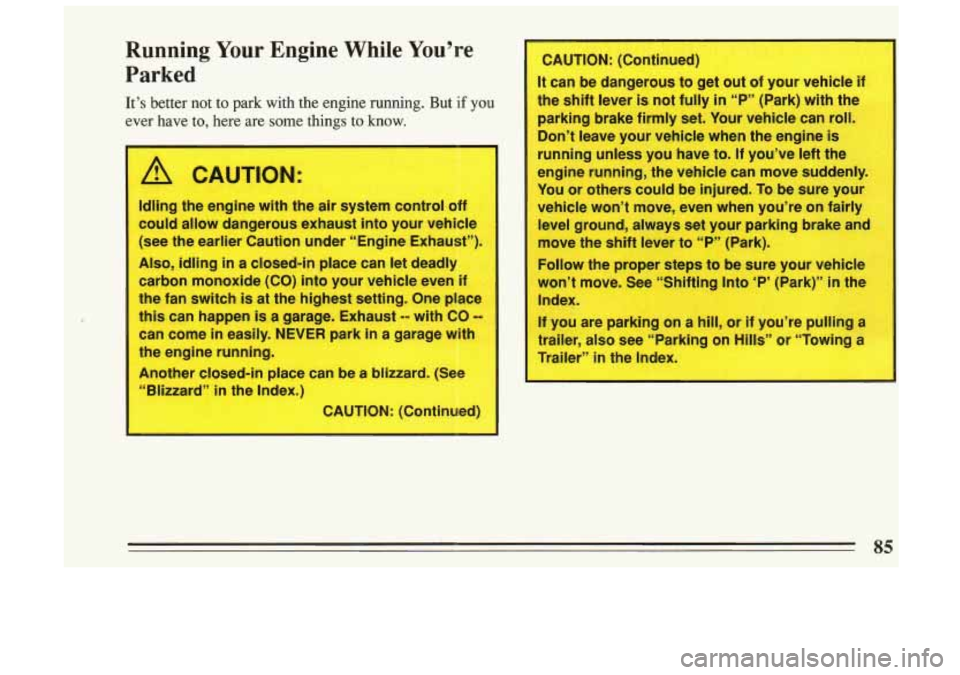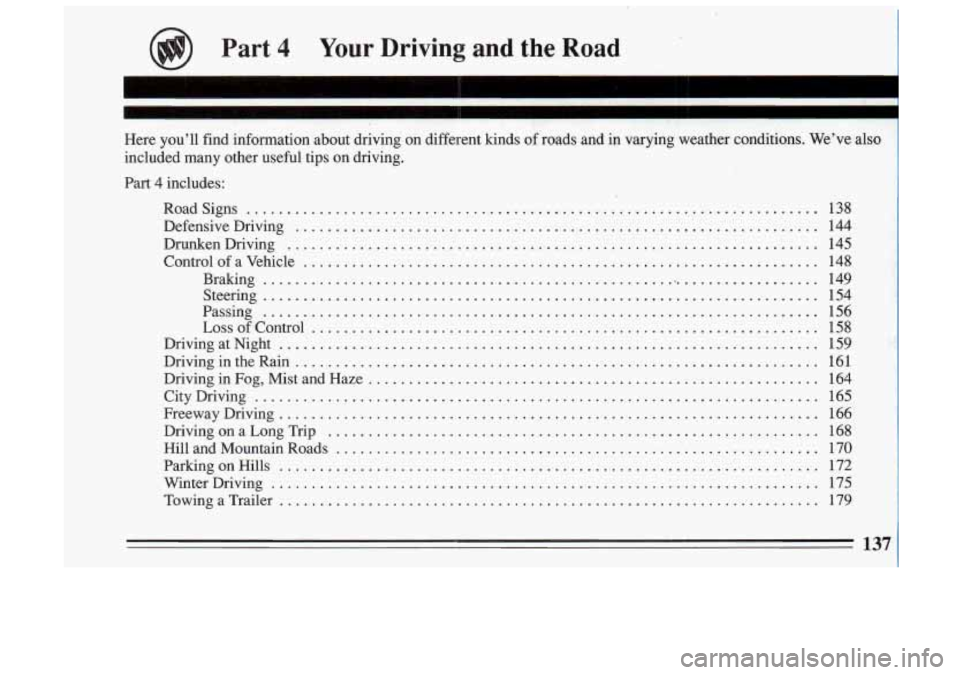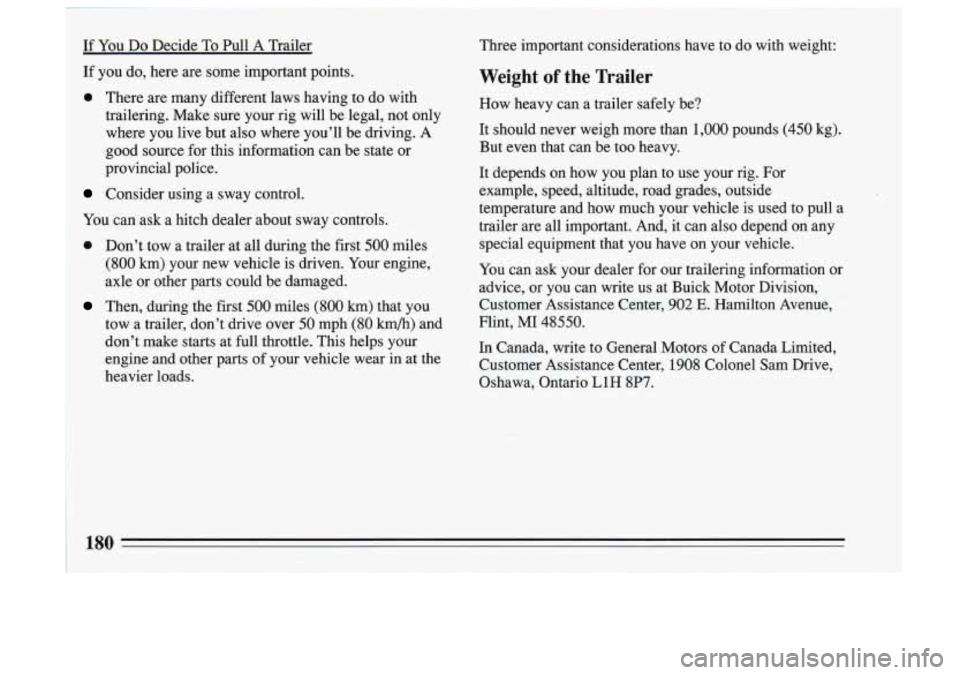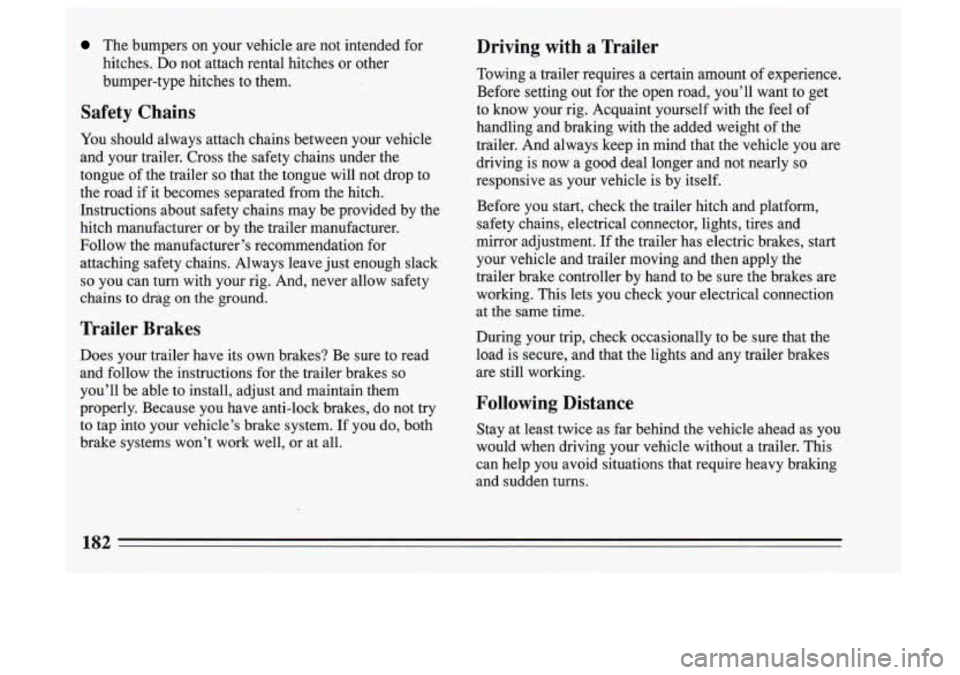1993 BUICK SKYLARK trailer
[x] Cancel search: trailerPage 78 of 306

Automatic Transaxle
There are several different positions for your shift lever.
P.(Park)
This locks your front wheels. It’s the best position to
use when you start your engine because your vehicle
can’t move easily.
A CAUTION:
It is dangerous to get out of your vehicle if the
shift lever
is not fully in “P” (Park) with the
parking brake firmly set. Your vehicle can
roll.
Don’t leave your vehicle when the engine is
running unless you have to. If you have left the
engine running, the vehicle can move suddenly.
You or others could be injured.
To be sure your
ehicle won’t move, when you’re on fairly level
ound, always set your parking brake and move
e shift lever to
“P” (Park). See “Shifting Into ‘P’
ark)”
in the Index. If you are parking on a hill
, if you’re pulling a trailer, also see “Parking on
11s” or “ Towing a Trailer” in the Index.
Ensure the shift lever is fully in “P” (Park) range before
starting the engine. Your Buick has a brake-transaxle
shift interlock. You have to fully apply your regular
brake before you can shift from “P” (Park) when the
ignition key is in the “Run” position.
If you cannot shift
out of
“P” (Park), ease pressure on the shift lever - push
the shift lever all the way into
“P,’ (Park) and also
release the shift lever button on floor shift console
models
- as you maintain brake application. Then move
77
Page 82 of 306

If YOU are on a hill: See “ Parking on Hills” in the Index.
That section shows how to tuk your front wheels.
If you are towing a trailer and are parking on any hill:
See
“ Towing a Trailer” in the Index. That section shows
what to do first to keep the trailer from moving.
Shifting Into 44 P 99 (Park)
I I
A CAUTION:
It can be dangerous to get out of your vehicle if
the shift lever is not fully in “PYy (Park) with the
parking brake firmly set. Your vehicle can roll.
If you have left the engine running, the vehicle
can move suddenly. You or others could be
injured. To be sure your vehicle won’t move,
when you’re on fairly level ground, use the steps
that follow.
If you are parking on a hill, or if
you’re pulling a trailer, also see “Parking On
Hills” or “Towing a Trailer”
in the Index.
Steering Column Shift Lever
1. Hold the brake pedal down with your right fuot and
2. Move the shift lever into “F”’ (Park) position like
set
the parking brake.
this:
0 Pull the lever toward you.
81
Page 86 of 306

P
-Running Your Engine While You’re
‘Parked
It’s better n.ot to park with the engine running. But if YOU
ever have to, here are~same things to how.
Idling the engine with tfie air 31 em control off
8could al~low dangerous exhaust into jour vehilcle
(see the earlier Cawtionunder “‘Engine IExhaust”:
Also, idling In a Closed-in> place can let‘ ‘dead.,
‘carbon monoxide
(CO) into yo~ur ve,hicle ewn if
t’he fan switch
is at the highest setting. One placl
this can happen is agarage. Exhaust -- with CO
can came in easily. #NEVER park in a garage with
the engine running.
Another clq3ed8-in;
place can be a blizzard. l(See
in the Index.)
nued:
It can ‘be dangerous ta get ‘olut lof ,your vehicle if
‘the shift lever is not fully
in T’ (Park) witlh trhe
parking brake flirmly set. Your vehicle
can roll.
Dm’t leave yaur vehic;le when the engine
is
running unless you have to. If you’ve lefi the
enlgine running, the vehicle can
move suddenly.
You
or others cou!ld be injured. To be sure yow’r
vehicle wonlpt move, even when
you’re on fair ~
level gramd, always set your parking brake and’
move
the shift lever to “P” (Park).
Follow the prope!r steps
to be sure your vehicle
wm’t move. See “S’hifting
Into ‘PB (Park)”’ in the
Inde?.
If
you are parking on a hill, or if you’lre pulling a
trailer,
atso see “Parking OM Hills”’ or “Towing, a
‘Trailer”
in th’e Index.
85
Page 138 of 306

Part 4 Your Driving and the Road
I
Here you’ll find information about driving on different kinds\
of roads and io varying weather conditions . We’ve also
included many other useful tips
on driving .
Part 4 includes:
RoadSigns
....................................................................... \
DefensiveDriving .................................................................
DrunkenDriving ..................................................................
ControlofaVehicle ................................................................
Braking ......................................................................
Steering .....................................................................
Passing .....................................................................
LossofControl ...............................................................
DrivingatNight ...................................................................
DrivingintheRain .................................................................
Driving in Fog, Mist and Haze ........................................................
CityDriving ......................................................................
FreewayDriving ...................................................................
DrivingonaLongTrip .............................................................
HillandMountainRoads ............................................................
ParkingonHills ...................................................................
WinterDriving ....................................................................
TowingaTrailer ...................................................................
138
144
145
148
149
154
156
158
159
161
164
165
166
168
170
172
175
179
Page 180 of 306

Towing a Trailer
A CAUTION:
If you don’t use the correct equipment and drive
properly, you can lose control when you pull
a
trailer. For example, if the trailer is too heavy. the
brakes may not work well
-- or even at all. Yo
and your passengers could be seriously injured.
Pull
a trailer only if you have followed all the
steps in this section.
i ~ ~, ~~ ~~
~~~ ~~ before you pull a trailer.
Your
car can tow a trailer.
To identify what the vehicle
trailering capacity is for your vehicle, you should read
the information in “Weight of the Trailer”. that appears
I later in this section. But trailering is different than just
driving your vehicle by itself. Trailering means changes
I in. handling, durability, and fuel economy. Successful,
safe trailering takes correct equipment, and it has to be
I used properly.
That’s the reason for this section. In it are many
time-tested, important trailering tips and safety rules. Many of these are important for your safety and that of
I your passengers. So please read this section carefully
Load-pulling components such as the engine, transaxle, wheel assemblies, and tires are forced to work harder
against the drag of the added weight. The engine is
greater loads, generating extra heat. What’s more, the
trailer adds considerably to wind resistance, increasing
the pulling requirements.
All of that means changes in:
ulling a trailer improper1 required to operate at relatively higher speeds and under
Do not tow a trailer if your vehicle is equipped with the
0 Handling
2.3 Liter, L4 engine. Durability
Fuel economy
179
Page 181 of 306

If You Do Decide To Pull A Trailer Three important considerations have to do with weight:
If you do, here are some important points.
Weight of the Trailer
0 There are many diflerent laws having to do with
How heavy can a trailer safely be?
trailering. Make sure your rig will be legal, not only
where you live but also where you’ll be driving. A It shou\
ld never weigh more than
1,000 pounds (450 kg).
good source for this information can be state or But even that can be too heavy.
provincial police. It depends on how you plan to use your
rig. For I
1 Consider using a sway control. example, speed, altitude, road g\
rades, outside
temperature and how much your vehicle is used
to pull a
trailer are all important. And, it can also depend on any
You can ask your dealer for our trailering information or
You
can ask a hitch dealer about sway controls.
0 Don’t tow a trailer at all during the first 500 miles special equipment that you have on your vehicle.
(800 km) your new vehicle is driven. Your engine,
axle or other parts could be damaged. advice, or you can write us \
at Buick Motor Division,
Then, during the first 500 miles (800 km) that you Customer Assistance Center, 902 E. Hamilton Avenue,
tow a trailer, don’t drive over
50 mph (80 h/h) and Hint, MI 48550.
don’t make starts at full throttle. This helps your
In Canada, write to General Motors of Canada Limited,
heavier loads. Oshawa, Ontario L1H
8P7.
en€!ine and other Paas Of Your wear in at the Customer Assistance Center, 1908 Colonel Sam Drive,
.I
Page 182 of 306

Weight of the Trailer Tongue
The tongue load (A) of any trailer is an important
weight to measure because it affects the total capacity
weight of your vehicle. The capacity weight includes the
curb weight of the vehicle, any cargo you may carry in
it, and the people who will be riding in the vehicle. And
if you will tow a trailer, you must subtract the tongue load from your vehicle’s capacity weight because your
vehicle will be carrying that weight, too. See “Loading
Your Vehicle” in the Index for more information about
your vehicle’s maximum load capacity. The trailer tongue (A) should weigh
10% of
the total
loaded trailer weight (B).
After you’ve loaded your trailer, weigh the trailer and
then the tongue, separately, to see if the weights are
proper. If they aren’t, you may be able to get them right
simply by moving some items around in the trailer.
Total Weight on Your Vehicle’s Tires
Be sure your vehicle’s tires are inflated to the limit for
cold tires. You’ll find these numbers on the Certification
label at the rear edge of the driver’s door (or see “Tire
Loading” in the Index). Then be sure you don’t go over
the GVW limit for your vehicle.
Hitches
It’s important to have the correct hitch equipment.
Crosswinds, large trucks going by, and rough roads are
a
few reasons why you’ll need the right hitch. Here are
some rules to follow:
Will you have to make any holes in the body of your
vehicle when you install a trailer hitch?
If you do,
then be sure to seal the holes later when you remove
the hitch. If you don’t seal them, deadly carbon
monoxide
(CO) from your exhaust can get into your
vehicle (see “Carbon Monoxide” in the Index).
Dirt
and water can, too.
181
Page 183 of 306

The bumpers on your vehicle are not intended for
hitches.
Do not attach rental hitches or other
bumper-type hitches to them.
Safety Chains
You should always attach chains between your vehicle
and. your trailer. Cross the safety chains under the
tongue of the trailer
so that the tongue will not drop to
the road if it becomes separated from the hitch.
Instructions about safety chains may be provided by the
hitch manufacturer or by the trailer manufacturer.
Follow the manufacturer’s recommendation for
attaching safety chains. Always leave just enough slack
so you can turn with your rig. And, never allow safety
chains to drag
on the ground.
Trailer Brakes
Does your trailer have its own brakes? Be sure to read
and follow the instructions for the trailer brakes
so
you’ll be able to install, adjust and maintain them
properly. Because you have anti-lock brakes, do not try
to tap into your vehicle’s brake system. ff you do, both
brake systems won’t work well, or at all.
Driving with a Trailer
Towing a trailer requires a certain amount of experience.
Before setting out for the open road, you’ll want to get
to know your rig. Acquaint yourself with the feel of
handling and braking with the added weight of the
trailer. And always keep in mind that the vehicle you are
driving is now a good deal longer and not.nearly
so
responsive as your vehicle is by itself.
Before you start, check the trailer hitch and platform,
safety chains, electrical connector, lights, tires and
mirror adjustment. If the trailer has electric brakes, start
your vehicle and trailer moving and then apply the
trailer brake controller by hand to be sure the brakes are working. This lets you check your electrical connection
at the same time.
During your trip, check occasionally to be sure that the
load
is secure, and that the lights and any trailer brakes
are still working.
Following Distance
Stay at least twice as far behind the vehicle ahead as you
would when driving your vehicle without a trailer. This
can help you avoid situations that require heavy braking
and sudden turns.